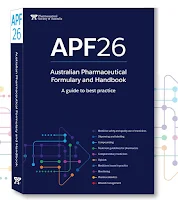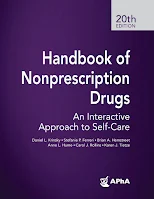Community Pharmacy Books
Introduction
One of the key principles that we were taught in pharmacy school is "first, do no harm".
- If we are unable to help the patients, but at least we should not make it worse.
- Hence, apart from providing remedies for common symptoms, it is just as vital to recognise the instances that you should refer your customers (patients) to seek medical attention from clinicians.
Few valuable community pharmacy references available on the market include
- Australian Pharmaceutical Formulary and Handbook, 2024
- Community Pharmacy: Symptoms, Diagnosis and Treatment, 2021 - Highly recommended
- Handbook of Nonprescription Drugs: An Interactive Approach to Self-Care, 2020
- MIMS Pharmacy Patient Counselling Guide, 2024
- Minor Illness or Major Disease, 2016
- Patient Assessment in Clinical Pharmacy, 2019
- Symptoms in the Pharmacy, 2025
Australian Pharmaceutical Formulary and Handbook, 2024
Still vivid in my mind, in my first week of community pharmacy placement in university years, my preceptor asked me to digest the content in these sections of Australian Pharmaceutical Formulary and Handbook 22.
- Counselling guides for managing minor ailments
- Provision of Pharmacist Only medicines
In a way, this is where all started. I began to learn about the essential skills: asking the right questions, recognizing when to refer, comparing products and mastering medication counselling.
NOTE: In APF 26, the essential guidance on managing a wide range of minor ailments (30 different topics) is covered in Treatment Guidelines for Pharmacists section.
Community Pharmacy: Symptoms, Diagnosis and Treatment, 2021
Out of the references listed, Community Pharmacy: Symptoms, Diagnosis and Treatment, 2021 is my favourite.
- I have been using this reference for both university assignments and readings during community pharmacy placement.
The same structure has been adopted for every condition.
- Background information on prevalence and aetiology
- Arriving at a differential diagnosis
- Trigger points indicative of referral
- Evidence base for OTC medication and practical prescribing
- Further reading and websites
Handbook of Nonprescription Drugs: An Interactive Approach to Self-Care, 2020
Handbook of Nonprescription Drugs is a useful resource for health care providers who counsel and care for patients undertaking self-treatment (nonprescription drugs, nutritional supplements, medical foods, nondrug and preventive measures and complementary therapies).
The content is very informative and contains quick-reference tools such as
- Treatment algorithms (including exclusions for self-treatment)
- Drug product tables
- Patient education sidebars
- Product administration illustrations
MIMS Pharmacy Patient Counselling Guide, 2024
MIMS Pharmacy Counselling Guide is a quick reference manual designed to help the pharmacists in responsible drug dispensing and patient counselling.
- It is updated annually.
For 2024/2025 edition, it covers a total of 60 common health topics. Each health topic contains the following information:
- Description/General Information
- Flowchart
- Patient Advice
- Referral to Physician
- Treatment Options
- Products Available
- Brand Highlight
Minor Illness or Major Disease, 2016
Minor Illness or Major Disease discusses in detail the diagnosis and management of frequently encountered ailments in community pharmacy practice.
- A problem-based learning approach with cases studies.
- Include trigger cases, management options, pharmacist and general practitioner opinions, self-assessment questions, summary of key points and key referral criteria.
Patient Assessment in Clinical Pharmacy, 2019
Patient Assessment in Clinical Pharmacy is a comprehensive resource for pharmacists looking to learn or improve crucial patient assessment skills relevant to pharmacy practice. This practical organised in 4 parts.
- Introductory chapters regarding the basics of patient assessment and components of patient care process
- A detailed assessment of common symptoms encountered by pharmacists in practice
- Assessment of patients with various chronic illnesses
- Select specialized topics and assessment considerations of interest to pharmacists
NOTE: Similar patient assessment textbooks for pharmacist include Patient Assessment in Pharmacy Practice, 2015 and Patient Assessment in Pharmacy, 2014.
Symptoms in the Pharmacy, 2025
Symptoms in the Pharmacy, 2025 is a very well written reference for community pharmacy practice. The structure of each health condition is as below.
- What you need to know? - Significance of relevant questions and answers
- When to refer
- Management (including treatment options) and practical points - with discussion on evidence
- Case studies
Summary
While community pharmacy reference books offer a crucial foundation for understanding common ailments, they cannot be the sole answer to every question.
- Each patient is unique, medical knowledge evolves quickly and complex cases arise.
- Pharmacists need to bridge this gap through their expertise, critical thinking, ongoing learning and collaboration with other healthcare professionals to provide optimal care beyond the textbook.









Comments
Post a Comment